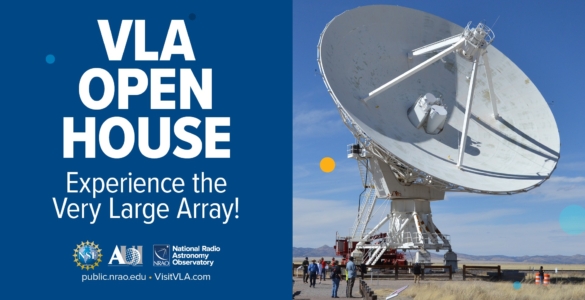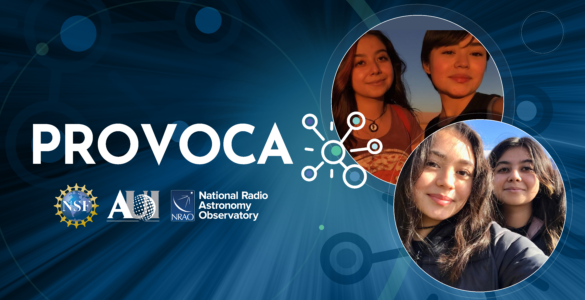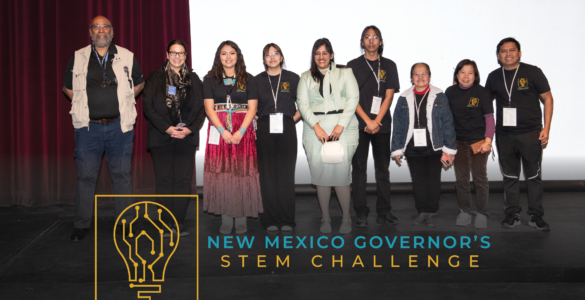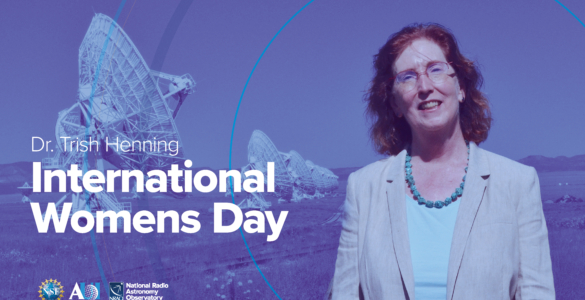September 28, 2022
VLA Reopening
The VLA is reopening to the public on October 1, 2022. See our Visit Us page for more details.
————–
September 29, 2021
All NRAO, GBO Facilities Are Operational
All NRAO and GBO scientific facilities are fully operational. ALMA has returned to full operations, and the VLA, VLBA, and GBT continue to operate fully as they have throughout the pandemic.
————–
March 15, 2021
ALMA Soon to Resume Science Observations
While the impact of COVID-19 continues to affect our lives worldwide, ALMA staff have been moving forward on the long road toward recovering the Arrays and resuming science operations. The ALMA antennas are in the process of being powered up and inspected one by one to make them ready for science observations. The positive news at this moment is that the tests from data acquisition to data processing have been successful.
The assessment of the safety and technical constraints, in addition to the success of the end-to-end tests, allows ALMA to start observing again. After a year of shutdown due to the pandemic, science operations should resume in March 2021.
“It has been a very challenging year for everybody. We had to suspend ALMA operations on behalf of staff safety,” says ALMA Director Sean Dougherty. “Given the circumstances, ALMA collaborators worked fantastically during the year, both from home and taking shifts to ensure the integrity of the observatory. It is now really exciting to be able to resume sciences operations, continuing to follow our detailed plan to reduce risks and keep all staff and collaborators safe as the top priority.”
In the beginning, science operations will be limited. At least forty of the sixty-six antennas will be available. Like regular operations, projects in the Cycle 7 observing queue will be executed if suitable for observation with the available number of antennas. The execution time will be increased to account for the lower sensitivity of the reduced number of antennas to achieve the sensitivity requested by the Primary Investigator. Also, test observations on capabilities for future cycles will be performed.
In parallel to science operations, ALMA continues to recover antennas to enable regular operations. All activities at the observatory are being conducted following an extensive set of safety protocols for managing the risk posed by the virus. As always, the health and safety of all ALMA staff is our top priority.
Status updates will be provided on a regular basis.
————–
October 1, 2020
ALMA Initiates Process of Restarting the Telescope Array
With the improving pandemic situation in Chile, ALMA Observatory is pleased to take the first steps towards reopening the telescope array in the Atacama, starting with the preparation of the Observatory Operations Support Facility (OSF) at 2,900 meters above sea level for the return of staff and contractors.
The road to recovery of operations, and ultimately science observations, has been carefully planned. Regular monitoring of the pandemic is performed each week.
“We are excited about this step towards a return to operations for ALMA,” said Phil Jewell, Deputy Director for the National Radio Astronomy Observatory and North American ALMA Director. “We hope that the pandemic situation in Chile and worldwide will continue to improve and we look forward to re-establishing science operations as soon as possible.”
ALMA developed an extensive set of enhanced safety protocols related to managing the risk posed by covid-19, covering all activities as the return to operations progresses. First, preparing the OSF for the return of staff and contractors, followed by moving back into the OSF and the use of the OSF facilities, before they begin the process of restarting the Array Operations Site (AOS) at 5,000 meters above sea level.
Status updates will continue to be provided as ALMA transitions from one phase to the next in the return to full operations.
See here for the latest updates on ALMA COVID-19 precautionary measures.
————–
March 17, 2020
ALMA Temporarily Suspends Science Observing
Due to the COVID-19 outbreak around the world, and in order to ensure the safety of all staff, the ALMA management has decided to temporarily suspend science observing at ALMA effective Thursday, 19 March 2020. A minimal crew has been defined in order to orderly ramp down to reduced operations. The array will be stowed during this time and only when deemed safe, PI science observations will resume.
The goal is to reduce the number of people at both sites, Santiago Central Offices and the Observatory in Northern Chile, to minimize the chances of infections and thereby maximize the safety and well-being of all staff and contractors.
See here for the latest updates on ALMA COVID-19 precautionary measures.
————–
March 13, 2020
Radio Observatories Closing to the Public in New Mexico, Virginia, West Virginia
In response to the governors of New Mexico, Virginia, and West Virginia closing the schools in those states, the National Radio Astronomy Observatory (NRAO) and the Green Bank Observatory (GBO) are closing their facilities in all three states. The closures affect the staffs and the visitor centers at the National Science Foundation’s Karl G. Jansky Very Large Array (VLA) in New Mexico, the Robert C. Byrd Green Bank Telescope (GBT) in Green Bank, WV, and NRAO Headquarters in Charlottesville, VA.
Under the closures, skeleton staffs will maintain scientific observing with the VLA, the Very Long Baseline Array (VLBA), and the GBT, and the remainder of the staffs will work from home as possible. Staff members working from home will be accessible via email and will endeavor to continue providing services. The visitor centers at both observatories will be closed to the public.
“Our priority is to protect the health of our staff and also to do our part in helping our states and communities combat the nationwide outbreak of Cornonavirus-19 Disease (COVID-19),” said Tony Beasley, Vice President for Radio Astronomy of Associated Universities, Inc., the organization that operates both NRAO and GBO for the NSF.
To date, no employees of either observatory have been diagnosed with COVID-19.
“As long as we can, we will continue to provide the service to the scientific community that is our mission. These measures seek to maximize the social distancing that will help reduce the spread of this disease,” Beasley said.
Observatory officials will continuously monitor the situation and the recommendations of the Centers for Disease Control and Prevention as well as of state agencies, and will take additional measures if necessary.
“This is a difficult time for our observatories and our nation, but I am confident that our team can support these public health initiatives and help keep our colleagues and our neighbors as safe as possible,” Beasley said.
The National Radio Astronomy Observatory and the Green Bank Observatory are facilities of the National Science Foundation, operated under cooperative agreement by Associated Universities, Inc.
————–
March 6, 2020
ALMA Cancels Public Visits
In order to safeguard staff and visitors well-being and the operation of the Atacama Large Millimeter/submillimeter Array (ALMA) Observatory, the ALMA public visits held every weekend will be cancelled until the end of April 2020. Please visit https://www.almaobservatory.org/ for the most recent updates on ALMA public visits.
###
Media Contacts:
Amy C. Oliver
Public Information Officer, ALMA
Public Information & News Manager, NRAO
+1 434 242 9584
aoliver@nrao.edu
Dave Finley, Public Information Officer, VLA, VLBA
Socorro, New Mexico
(575) 835-7302
dfinley@nrao.edu










